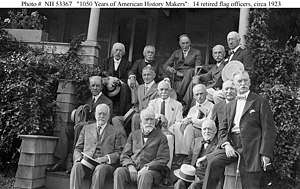William T. Swinburne
William T. Swinburne (August 24, 1847 – March 3, 1928) was a rear admiral of the United States Navy and one-time Commander-in-Chief of the United States Pacific Fleet.
William T. Swinburne | |
|---|---|
| Born | August 24, 1847 Newport, Rhode Island |
| Died | March 3, 1928 (aged 80) Coronado, California |
| Allegiance | |
| Service/ | |
| Years of service | 1862–1909 |
| Rank | |
| Commands held | Pacific Squadron |
| Battles/wars | American Civil War Spanish–American War |

Biography
He was born in Newport, Rhode Island, and entered the Navy on September 29, 1862 as a cadet midshipman at the United States Naval Academy.
He graduated from the Academy in 1866 as a Passed Midshipman. He was promoted to ensign in April 1868, master on March 26, 1869, lieutenant on March 21, 1880 and lieutenant commander in March 1887.
He was Commander-in-Chief of the Pacific Squadron from 1906 to the formation of the Pacific Fleet in 1907. He remained as Commander-in-Chief of the Pacific Fleet until his retirement on August 24, 1909.
He died in Coronado, California and was buried at sea in accordance with his will.[1] His body was carried by the scout cruiser USS Omaha and consigned to the sea about 20 miles off Point Loma, San Diego on March 5, 1928.[2]
He was a member of the California Commandery of the Military Order of the Loyal Legion of the United States and was assigned insignia number 15949. He was also a member of the Military Order of Foreign Wars and was assigned insignia number 411.
References
- "Veteran Admiral to Have Sea Burial". New York Times. 1928-03-05. p. 21.
- "Body Buried at Sea". Evening Star. Washington, D.C. March 6, 1928.
| Military offices | ||
|---|---|---|
| Preceded by none |
Commander in Chief of the United States Pacific Fleet 17 May 1909-19 February 1910 |
Succeeded by Uriel Sebree |